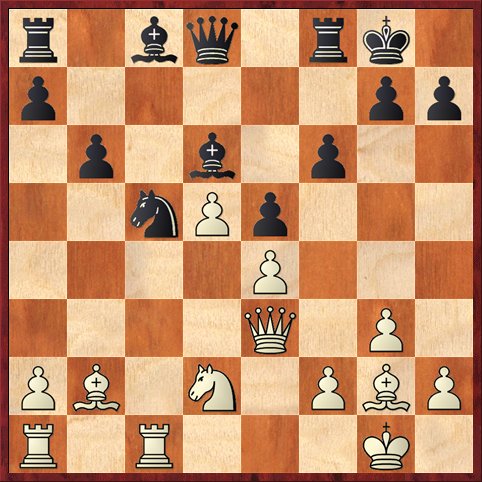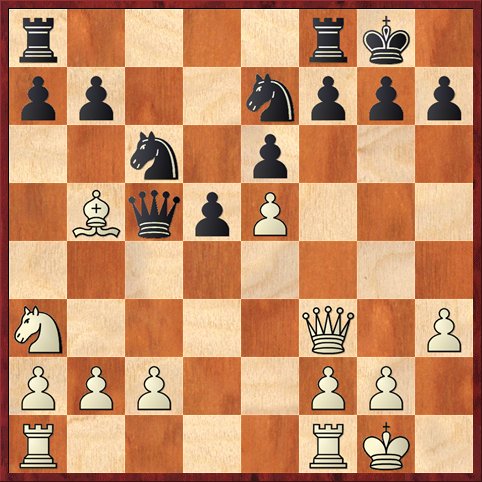Since the last time I wrote, my problems have gotten even worse. My Internet connection has not been working since last Friday. Our working hypothesis is that it’s a problem with the modem and it will be resolved when we get our new modem on Wednesday. I sure hope that’s the problem, because otherwise I foresee a lifetime of very short blog posts written in Internet cafes and coffeehouses. Like this one.
Once I can get back on the Internet at home, I’ll see if I can fix the earlier problem with the comments not working. But first things first.
I promised you a post with three more positions from my CalChess tournament, so here they are — but only two positions because I don’t have time for all three.
 FEN: r1bq1rk1/p5pp/1p1b1p2/2nPp3/4P3/4Q1P1/PB1N1PBP/R1R3K1 b – – 0 17
FEN: r1bq1rk1/p5pp/1p1b1p2/2nPp3/4P3/4Q1P1/PB1N1PBP/R1R3K1 b – – 0 17
Position after 17. Qe3. Black to move.
In round four I played Black against Teemu Virtanen, who eventually tied for first in the expert section. I was very impressed with his calm and rational play.
I did multiple things wrong in this game, starting with move one, where I answered his 1. c4 with 1. … Nf6 instead of my usual 1. … c5. But I can’t exactly show move one as a position for discussion, can I?
The above position was where I played my first really delusional move. He had just moved his king rook to c1 a couple moves earlier and I thought, “Hey! I can take advantage of this move to exchange off his dark-squared bishop!” So I played 17. … Na4? 18. Ba3 Bxa3 19. Qxa3. The reason that this was delusional was that I had just spent four tempi moving my knight from b8 to c6 to a5 to b7 to c5, and now I’m moving it again and I will certainly have to move it back to c5 one more time before I’m done. That’s six knight moves while the rest of my army stands mostly undeveloped. This kind of insult to the laws of chess cannot go unpunished. In fact, White was able to put lots of pressure on the b- and c-files, and with the aid of some more blunders by me he was able to win with the greatest of ease.
Better options would have been 17. … Bd7 or 17. … Bb7. I’ll let you take your pick.
The critical position in round five was also the final position. I was White against William Li.
 FEN: r4rk1/pp2nppp/2n1p3/1BqpP3/8/N4Q1P/PPP2PP1/R4RK1 w – – 0 13
FEN: r4rk1/pp2nppp/2n1p3/1BqpP3/8/N4Q1P/PPP2PP1/R4RK1 w – – 0 13
Position after 12. … O-O. White to move.
In this position my young opponent offered a draw, and I accepted. He was quite surprised! Then in our postmortem session I showed him line after line where Black gets a very significant advantage.
But let’s skip the analysis for now. Why does Black have a big advantage?
- White has weaknesses all over the place. The e5 pawn is the biggest one. Also the c2 pawn, the b2 pawn, and potentially even the f2 pawn. (This was not evident to my opponent. But it comes up in two variations. If I play 13. Rfe1, which he thought I should do, he can play 13. … f6 14. ef Rxf6 and the f2 pawn is hurting big time. Also, if I play 13. Bd3, which I was intending to do, he can play 13. … Ng6 14. Bxg6 fg!? and again the opening of the f-file has major consequences: he can lift his rook to f5, double on the f-file, etc.)
- Black’s queen is beautifully centralized. White’s queen is not, and will have to move again.
- Black has beautiful files for his rooks. The c-file for now, the b-file if I trade on c6, and the f-file in the two variations above. White has no effective place for his rooks.
- White’s knight on a3 is a pitiful creature. After a trade on c6 it would have no moves, except back to b1. And notice that it’s under attack too, so in the lines that start 13. Bxc6 bc, the move b3 is never a possibility.
- White will be forced to trade off his only active piece, the bishop, or else lose the e5 pawn. The trade can happen in several ways: 13. Bxc6 right away, or 13. Bd3 Ng6 14. Bxg6, or even 13. Bd3 Nxe5 14. Bxh7+ Kxh7 15. Qh5+. Of the three ways, the last one is the only one that gives me any consolation, because at least I’ve weakened his king position a little bit.
Maybe I should just sac the e5 pawn, but it doesn’t look as if I get much for it.
Conclusion: White’s position is awful, awful, awful. Black should have played on so that he could learn how to win such positions. Of course I was a little disappointed to settle for a 12-move draw against a player rated 200 points below me, but much more than that I was glad to say “Goodbye and good riddance” to this position.
Well, my time in the coffeehouse is up, so I will talk about round six in my next post, hopefully after I get my Internet access restored.


